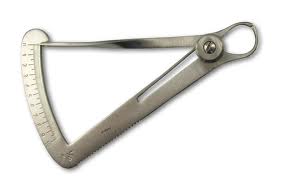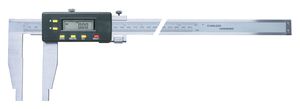Calipers
Caliper is a device used to measure the distance between two opposite sides of an object. A caliper can be as simple as a compass with inward or outward-facing points. The tips of the caliper are adjusted to fit across the points to be measured, the caliper is then removed and the distance read by measuring between the tips with a measuring tool, such as a ruler. It is used in many fields such as mechanical engineering , metalworking, woodworking, science and medicine.
Types
Inside caliper
The inside calipers are used to measure the internal size of an object. It requires manual adjustment prior to fitting, fine setting of this caliper type is performed by tapping the caliper legs lightly on a handy surface until they will almost pass over the object. A light push against the resistance of the central pivot screw then spreads the legs to the correct dimension and provides the required, consistent feel that ensures a repeatable measurement.Some caliper has an adjusting screw that permits it to be carefully adjusted without removal of the tool from the workpiece.
Outside caliper
Outside calipers are used to measure the external size of an object. The same observations and technique apply to this type of caliper, as for the above inside caliper. With some understanding of their limitations and usage these instruments can provide a high degree of accuracy and repeatability. They are especially useful when measuring over very large distances, consider if the calipers are used to measure a large diameter pipe. A vernier caliper does not have the depth capacity to straddle this large diameter while at the same time reach the outermost points of the pipe's diameter.
Divider caliper
In the metalworking field divider calipers are used in the process of marking out suitable workpieces. The points are sharpened so that they act as scribers, one leg can then be placed in the dimple created by a center or prick punch and the other leg pivoted so that it scribes a line on the workpiece's surface, thus forming an arc or circle.
A divider caliper is also used to measure a distance between two points on a map. The two caliper's ends are brought to the two points whose distance is being measured. The caliper's opening is then either measured on a separate ruler and then converted to the actual distance, or it is measured directly on a scale drawn on the map. On a nautical chart the distance is often measured on the latitude scale appearing on the sides of the map: one minute of arc of latitude is approximately one nautical mile or 1852 metres. Dividers are also used in the medical profession. An ECG also EKG caliper transfers distance on an electrocardiogram; in conjunction with the appropriate scale, the heart rate can be determined. A pocket caliper versions was invented by cardiologist Robert A. Mackin.
Oddleg caliper
Oddleg calipers, Hermaphrodite calipers, or Oddleg jennys, are generally used to scribe a line a set distance from the edge of a workpiece. The bent leg is used to run along the workpiece edge while the scriber makes its mark at a predetermined distance, this ensures a line parallel to the edge. Some caliper has a slight shoulder in the bent leg allowing it to sit on the edge more securely, other caliper lacks this feature but has a renewable scriber that can be adjusted for wear, as well as being replaced when excessively worn.
Vernier caliper
The vernier, dial, and digital calipers give a direct reading of the distance measured to high accuracy. They are functionally identical, with different ways of reading the result. These calipers comprise a calibrated scale with a fixed jaw, and another jaw, with a pointer, that slides along the scale. The distance between the jaws is then read in different ways for the three types.
The simplest method is to read the position of the pointer directly on the scale. When the pointer is between two markings, the user can mentally interpolate to improve the precision of the reading. This would be a simple calibrated caliper; but the addition of a vernier scale allows more accurate interpolation, and is the universal practice; this is the vernier caliper.
Vernier, dial, and digital calipers can measure internal dimensions , external dimensions using the pictured lower jaws, and in many cases depth by the use of a probe that is attached to the movable head and slides along the centre of the body. This probe is slender and can get into deep grooves that may prove difficult for other measuring tools.
Dial caliper
Instead of using a vernier mechanism, which requires some practice to use, the dial caliper reads the final fraction of a millimeter or inch on a simple dial. In this instrument, a small, precise gear rack drives a pointer on a circular dial, allowing direct reading without the need to read a vernier scale. Typically, the pointer rotates once every inch, tenth of an inch, or 1 millimeter. This measurement must be added to the coarse whole inches or centimeters read from the slide. The dial is usually arranged to be rotatable beneath the pointer, allowing for differential measurements . The slide of a dial caliper can usually be locked at a setting using a small lever or screw; this allows simple go/no-go checks of part sizes.
Digital caliper
A refinement now popular is the replacement of the analog dial with an electronic digital display on which the reading is displayed as a single value. Some digital calipers can be switched between centimeters or millimeters, and inches. All provide for zeroing the display at any point along the slide, allowing the same sort of differential measurements as with the dial caliper. Digital calipers may contain some sort of reading hold feature, allowing the reading of dimensions even in awkward locations where the display cannot be seen.
Some digital calipers contain a capacitive linear encoder. A pattern of bars is etched directly on the printed circuit board in the slider. Under the scale of the caliper another printed circuit board also contains an etched pattern of lines. The combination of these printed circuit boards forms two variable capacitors. The two capacitances are out of phase. As the slider moves the capacitance changes in a linear fashion and in a repeating pattern. The circuitry built into the slider counts the bars as the slider moves and does a linear interpolation based on the magnitudes of the capacitors to find the precise position of the slider. Other digital calipers contain an inductive linear encoder, which allows robust performance in the presence of contamination such as coolants. Magnetic linear encoders are used in yet other digital calipers.
Micrometer caliper
A caliper using a calibrated screw for measurement, rather than a slide, is called a micrometer caliper or, more often, simply a micrometer.
Use
A caliper must be properly applied against the part in order to take the desired measurement. For example, when measuring the thickness of a plate a vernier caliper must be held at right angles to the piece. Some practice may be needed to measure round or irregular objects correctly.
Accuracy of measurement when using a caliper is highly dependent on the skill of the operator. Regardless of type, a caliper's jaws must be forced into contact with the part being measured. As both part and caliper are always to some extent elastic, the amount of force used affects the indication. A consistent, firm touch is correct. Too much force results in an under indication as part and tool distort; too little force gives insufficient contact and an over indication. This is a greater problem with a caliper incorporating a wheel, which lends mechanical advantage. This is especially the case with digital calipers, calipers out of adjustment, or calipers with a poor quality beam.
Simple calipers are uncalibrated; the measurement taken must be compared against a scale. Whether the scale is part of the caliper or not, all analog calipers—verniers and dials—require good eyesight in order to achieve the highest precision. Digital calipers have the advantage in this area. Calibrated calipers may be mishandled, leading to loss of zero. When a calipers' jaws are fully closed, it should of course indicate zero. If it does not, it must be recalibrated or repaired. It might seem that a vernier caliper cannot get out of calibration but a drop or knock can be enough. Digital calipers have zero set buttons.
Vernier, dial and digital calipers can be used with accessories that extend their usefulness. Examples are a base that extends their usefulness as a depth gauge and a jaw attachment that allows measuring the center distance between holes. Since the 1970s a clever modification of the moveable jaw on the back side of any caliper allows for step or depth measurements in addition to external caliper measurements, in similar fashion to a universal micrometer .

